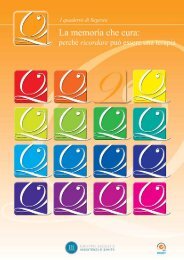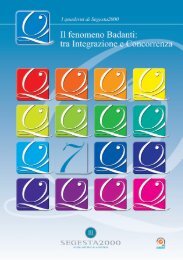La Ventilazione non invasiva nel paziente cronico riacutizzato : dove ...
La Ventilazione non invasiva nel paziente cronico riacutizzato : dove ...
La Ventilazione non invasiva nel paziente cronico riacutizzato : dove ...
Create successful ePaper yourself
Turn your PDF publications into a flip-book with our unique Google optimized e-Paper software.
Il percorso assistenziale del <strong>paziente</strong> critico:<br />
dalla Terapia Intensiva al Territorio<br />
Corrado A, Augustynen A, Bertini S<br />
SOD Terapia Intensiva Pneumologica<br />
E Fisiopatologia Toracica<br />
Az. Ospedaliera-Universitaria di Careggi, Firenze<br />
24 maggio 2011<br />
Salone dei Duecento<br />
Palazzo Vecchio<br />
Firenze<br />
Il <strong>paziente</strong> con insufficienza respiratoria<br />
A. O. U.<br />
CAREGGI<br />
FIRENZE
Function<br />
High<br />
Low<br />
COPD<br />
*CRF: Chronic Respiratory Failure<br />
Long Term<br />
Oxygen Therapy<br />
CRF*<br />
Time<br />
Long Term<br />
Ventilation<br />
END-STAGE<br />
Transplantation<br />
?<br />
Death
Organ system failure trajectory<br />
High<br />
Function<br />
Low<br />
Begins to use hospital<br />
often; self-care<br />
becomes difficult<br />
Time<br />
Mostly heart and lung failure<br />
Death<br />
Field MJ 1997<br />
2-5 years, but death<br />
usually seems sudden
Global Alliance against Chronic Respiratory Diseases
%<br />
80<br />
70<br />
60<br />
50<br />
40<br />
30<br />
20<br />
TIPOLOGIA di PAZIENTI ricoverati in UTIP<br />
ANNI 2002-2009<br />
53,6<br />
46,3<br />
46,7<br />
2002-2005 2006-2009<br />
BPCO NO-BPCO<br />
53,3
NON BPCO<br />
Fibrosi cistica<br />
1%<br />
Tumori<br />
solidi/emopoietici<br />
10%<br />
Obesità/Overlap<br />
9%<br />
Altre<br />
9%<br />
Interstiziopatie<br />
6%<br />
SLA/DM/Mal<br />
Neuromuscolari<br />
18%<br />
Asma<br />
4%<br />
Patologie<br />
cardiovascolari<br />
31%<br />
Fibrotorace/cifoscol<br />
iosi<br />
12%
SCLEROSI<br />
LATERALE<br />
AMIOTROFICA
NUMERO PAZIENTI<br />
REGISTRO<br />
TOSCANO delle<br />
MALATTIE RARE<br />
148<br />
235<br />
Incidenza SLA<br />
54<br />
93<br />
2000-04 2005-09 2000-04 2005-09<br />
regione TOSCANA area CENTRO
High<br />
Function<br />
Low<br />
SCLEROSI<br />
LATERALE<br />
AMIOTROFICA<br />
INSUFFICIENZA<br />
RESPIRATORIA<br />
Time<br />
Debolezza<br />
muscoli respiratori<br />
<strong>Ventilazione</strong> meccanica<br />
Tosse inefficace<br />
Aiuti alla clearance<br />
disfagia<br />
Nutrizione artificiale<br />
Death
PERCORSO PER PAZIENTI AFFETTI DA SCLEROSI LATERALE AMIOTROFICA<br />
1. PRENOTAZIONE 1^<br />
VISITA NEUROLOGICA<br />
CUP<br />
PROCEDURA<br />
2. VISITA<br />
GESTIONE DEL PERCORSO NEUROLOGICA D.T.A.<br />
Neurologo<br />
DI SOGGETTI AFFETTI DA<br />
3. COMUNICAZIONE<br />
DIAGNOSI<br />
Equipe multidisciplinare<br />
SCLEROSI LATERALE<br />
4. PRESCRIZIONE TERAPIA<br />
AMIOTROFICAFARMACOLOGICA<br />
e<br />
VALUTAZIONE DIETETICA<br />
Neurologo, Dietista<br />
<strong>La</strong> presente procedura è applicata 5. CONTROLLI dal personale<br />
PROGRAMMATI<br />
AMB. NEUROLOGIA<br />
sanitario operante <strong>nel</strong>le seguenti strutture:<br />
Neurologo<br />
AAD Servizio di fisioterapia e riabilitazione<br />
neurologica<br />
AAD Servizio di fisioterapia e riabilitazione<br />
ACCESSO IN<br />
URGENZA<br />
NO<br />
respiratoria<br />
DA PS<br />
Area di Attività Dietetica (Servizio Tecnico Sanitario)<br />
8bis. RICOVERO<br />
SOD Agenzia della nutrizione IN NEUROLOGIA<br />
Neurologo<br />
SOD Agenzia di continuità assistenziale<br />
extraospedaliera<br />
SOD Audiologia<br />
10. CONFEZIONAMENTO<br />
SOD Clinica delle organizzazioni<br />
PEG<br />
Chirurgo<br />
SOD Endoscopia chirurgica<br />
SOD Neurologia 1 e relative Aree di Attività<br />
12. TRASFERIMENTO IN<br />
Dipartimentali<br />
NEUROLOGIA<br />
Neurologo, Dietista<br />
SOD Neurologia 2<br />
SOD Otorinolaringoiatria<br />
SOD Terapia Intensiva Pneumologica e Fisiopatologia<br />
Toracica<br />
6. VALUTAZIONE CLINICA<br />
FUNZIONALE IN DH UTIP<br />
Pneumologo, Dietista,<br />
Fisioterapista, Foniatra<br />
7. CONTROLLI<br />
PROGRAMMATI IN DH UTIP<br />
Pneumologo, Dietista,<br />
Fisioterapista, Foniatra<br />
PEG/<br />
Tracheo<br />
?<br />
8. RICOVERO<br />
PROGRMMATO/IN<br />
URGENZA IN UTIP<br />
Pneumologo<br />
14. DIMISSIONE<br />
DOMICILIO/<br />
LUNGODEGENZA<br />
SI<br />
11. ESECUZIONE<br />
TRACHEOSTOMIA<br />
ORL<br />
P/903/…<br />
Ed. 1<br />
Rev. 0<br />
NIV/<br />
Tosse A.<br />
?<br />
SI<br />
13. TRASFERIMENTO<br />
IN STRUTTURA<br />
CONVENZIONATA<br />
INTERMEDIA<br />
NO<br />
9. ADATTAMENTO A NIV/<br />
Tosse Assistita in DH UTIP<br />
Pneumologo, Fisioterapista
GIORNI
ALTRE CATEGORIE DI PAZIENTI CON IR RICOVERATI<br />
IN UTIP dal 2002 al 2009 CON DIFFICOLTA’ DI<br />
DIMISSIONE<br />
Giorni Degenza (Mediana)<br />
20<br />
18<br />
16<br />
14<br />
12<br />
10<br />
8<br />
6<br />
4<br />
2<br />
0<br />
19<br />
11<br />
8<br />
Totale paz: 313<br />
•TIG: 215<br />
•Chirurgia: 36<br />
•TINCH: 15<br />
•TICCH: 47<br />
Precedente UTIP Stabiliz. Differenza<br />
3
PAZIENTI RICOVERATI PER INSUFFICIENZA RESPIRATORIA<br />
IN UTIP DAL 2002 AL 2009 E TRASFERITI PRESSO<br />
STRUTTURE RIABILITATIVE/DI LUNGA DEGENZA<br />
Giorni Degenza (Mediana)<br />
25<br />
20<br />
15<br />
10<br />
5<br />
0<br />
6<br />
13<br />
23<br />
17<br />
18<br />
12,5<br />
5 4,5<br />
Precedente UTIP Stabiliz. Differenza<br />
Lungo Degenza Riabilitazione<br />
Totale paz: 143<br />
Longodegenza: 63<br />
Riabilitazione: 80
Medical resources<br />
(COSTS)<br />
GREATEST<br />
LEAST<br />
ACUTE CARE<br />
Critical Care Unit<br />
Respiratory Care Unit<br />
General Medical/Surgical Unit<br />
INTERMEDIATE CARE<br />
Subacute Care Unit<br />
Long-term Care Hospital<br />
Rehabilitation Hospital<br />
LONG-TERM CARE<br />
Skilled Nursing Facility<br />
Congregate Living Center<br />
Home care<br />
Patient independence<br />
(QoL)<br />
LEAST<br />
GREATEST
Nocturnal Home Monitoring of patients<br />
with chronic respiratory failure in long<br />
term mechanical ventilation: role of<br />
teleassitence in the course of chronic<br />
disease
AIM<br />
To evaluate if, in patients with advanced chronic respiratory failure<br />
in domiciliary treatment with chronic mechanical ventilation, a<br />
nocturnal monitoring of cardiorespiratory and mechanical ventilatory<br />
variables by a remote control supervised by a team highly skilled<br />
may improve the outcomes of the disease in terms of a better<br />
control, a reduction in the number of exacerbations and of<br />
hospitalization, with improvement in quality of life.<br />
END-POINTS<br />
PRIMARY: optimization of the domiciliary treatment and reduction of<br />
number of exacerbations and of hospital admission.<br />
SECONDARY: evaluation of the impact of the tele-assistance on the<br />
perception of the patients in terms of usefullness of the<br />
service, safety, and facilitation in the management of the<br />
disease.
STUDY DESIGN<br />
Type and duration of the study. 2-years observational study<br />
(from 1° October 2008 to 30 September 2010)<br />
Patients. 20 patients with hypercapnic chronic respiratory<br />
insufficiency due to neuromuscular diseases, Kiphoscoliosis, COPD<br />
Inclusion Criteria: Patients in home mechanical ventilation for<br />
at least 1 year and for or more than 8 hours/day<br />
Esclusion criteria : OSA, Hypoventilation obesity syndrome<br />
Planned monitoring: nocturnal home monitoring of ventilatory<br />
and SaO2 parameters during mechanical ventilation (MV) by<br />
means of a web-based integrated approach of technologies<br />
developed by Telecare and Qubisoft
INTERVENTION<br />
Once a week all patients underwent, during mechanical<br />
ventilation, nocturnal home monitoring of the following<br />
parameters: Tidal Volume, Respiratory Frequency, Minute<br />
Ventilation, SaO2, Heart rate, and IPAP and EPAP using a<br />
digital multiparametric recorder (SALLY PA) .<br />
Sally PA ® allows acquisition and<br />
storage of multiple <strong>non</strong>-invasive<br />
clinical data. To facilitate data<br />
accessibility, it is designed to collect<br />
and transmit data via Internet. Sally<br />
can monitor the parameters of any<br />
ventilator.<br />
Telephone counselling 24hours/24 with medical doctors<br />
in charge in UTIP, when needed.
INTERVENTION<br />
Acute medical problems and alarms generated by the<br />
ventilator were immediately reported by phone to the<br />
doctor in charge in UTIP, who in real time, looking at the<br />
monitorized traces was able to suggest the solution for<br />
the specific problem.<br />
Intervention of emergency ambulance ( 118) in case of<br />
failure of telephone counseling.<br />
Patients were followed with regular visits every two<br />
months by the outpatient clinic of UTIP.<br />
Involvement of general practitioner for an integrated<br />
management of the patient.
20 months<br />
COMPLETE<br />
(n=10)<br />
regular<br />
transmission of<br />
data and regular<br />
follow-up<br />
Eligible Patients (n= 20)<br />
Patients enrolled (n=15)<br />
Died (n=5)<br />
Died (n=5)<br />
Actual Patients in follow-up (n=10)<br />
COMPLIANCE TO STUDY PROTOCOL<br />
PARTIAL<br />
(n=2)<br />
sporadic<br />
transmission of<br />
data and regular<br />
follow-up<br />
LOW<br />
(n=2)<br />
One transmission<br />
of data and<br />
regular follow-up<br />
ABSENT<br />
(n=1)<br />
No transmission<br />
of data no<br />
regular follow-up
TYPE OF DISEASE and MECHANICAL VENTILATION, HOURS/DIE<br />
OF TREATMENT<br />
Disease Pats n IMV* hrs/die IMV NIV hrs/die NIV<br />
ALS 3 2 24/24 1 16/24<br />
MD 4 2 24/24 2 8/24<br />
COPD 4 1 24/24 3 8/24<br />
Kiphoscoliosis 1 1 8/24<br />
Poliomielytis 1 1 8/24<br />
Acrodisostosis 1 1 8/24<br />
Ondine S. 1 1 8/24<br />
Tot 15 5 11<br />
*IMV= Invasive Mechanical Ventilation;<br />
§ NIV=Non Invasive mechanical Ventilation
Overall hospital stay and number of hospital admission in 15 pats<br />
2 previous years From the start of the study (%)<br />
n hosp. adm 13 8 - 39<br />
hosp. stay, days 157 133 -15<br />
Hospital stay and number of hospital admission in Patients with good<br />
adherence to the protocol (n 10)<br />
2 previous years From the start of the study (%)<br />
N Hosp. Adm 11 4 - 64<br />
hosp stay, days 144 81 -44<br />
Hospital stay and number of hospital admission in pats with scarce or<br />
no adherence to the protocol (n 5)<br />
2 previous years From the start of the study (%)<br />
N hosp. adm 2 4 + 100<br />
hosp stay, days 13 52 + 300
Satisfaction Score by telephone Questionnaire<br />
a) Is the service of teleassistence useful?<br />
0 = no/indifferent<br />
1 = yes, a little<br />
2 =yes, moderately<br />
3 =yes, completely<br />
b) Do you feel save with this service?<br />
0 = no/indifferent<br />
1 = yes, a little<br />
2 =yes, moderately<br />
3 =yes, completely<br />
c) Has this service improved the management of your disease?<br />
0 = no/indifferent<br />
1 = yes, a little<br />
2 =yes, moderately<br />
3 =yes, completely<br />
LEVEL OF SATISFACTION OF USERS<br />
n pats score %,score<br />
1 0/9 0<br />
1 2/9 22<br />
1 5/9 56<br />
3 6/9 67<br />
1 7/9 78<br />
3 9/9 100<br />
Tot 10 6/9 67<br />
Level of satisfaction of users according to the aderence to the protocol<br />
aderence to protocol no aderence to protocol<br />
n ,pats score %,score n pats score %,score<br />
2 6/9 67 1 0/9 0<br />
1 7/9 78 1 5/9 56<br />
3 9/9 100 1 6/9 77<br />
1 2/9 22<br />
Tot 6 8/9 89 4 3/9 33
controls<br />
controls<br />
Tele-assistance group<br />
Tele-assistance group
CONCLUSIONI I<br />
1. Negli ultimi anni abbiamo registrato pazienti<br />
ricoverati in UTIP per IR con più elevate<br />
complessità assistenziali rispetto alla BPCO. Fra<br />
questi prevalgono pazienti affetti da patologia<br />
cardiovascolare e neuromuscolare di varia<br />
natura<br />
2. <strong>La</strong> mancanza di strutture sul territorio di<br />
supporto per la gestione della fase riabilitativa<br />
ed educativa per il “management” della cronicità<br />
allunga i tempi di degenza in terapia intensiva e<br />
peggiora la qualità di vita del <strong>paziente</strong><br />
cronicamente critico
CONCLUSIONI II<br />
3. <strong>La</strong> creazione di percorsi ospedale-territorio<br />
specifici per patologie omogenee potrebbe<br />
migliorare la qualità di vita dei pazienti e ridurre<br />
i costi di gestione<br />
4. I programmi di tele-assistenza potrebbero<br />
costituire un valido supporto <strong>nel</strong>la gestione<br />
domiciliare in sicurezza di pazienti con<br />
insufficienza respiratoria cronica in ventilazione<br />
meccanica















